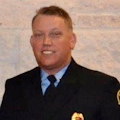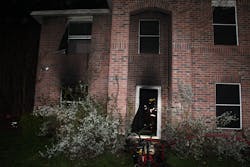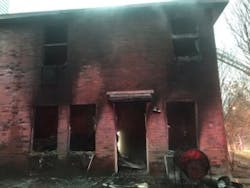Adding 'Rescue Mode' to Blue Card Incident Command
In 2017, my regional training chief asked me if I would be interested in attending the Blue Card Incident Command Instructor course. I'm sure that he could see the hesitation on my face, and he explained that this was an incident command program created by the Godfather, Chief Alan Brunaccini. Of course, hearing this, I was all in. I met Chief Brunaccini early in my career and I will never forget sitting in awe, praying that I would be that good someday. While I may have accomplished a lot in life, I might have set the bar too high there.
As I attended the Blue Card class with several other officers and leaders from our region, we learned a lot about the system, and on breaks we discussed how we could come back and implement that into our own current system. Yes, this is the fire service, and we did face fierce opposition trying to introduce something new. However, after several months of training in the field and classroom, we were able to roll it out. At the time, I had only one concern about the program, and it revolved around making a rescue.
In class, mayday situations were frequently discussed, but not much was said about the routine rescue, or grab. While in class, I did probe some of the instructors, including Nick Brunaccini, about what happens when we have to affect a rescue because our system is not like the Phoenix Fire Department — we run with only three on an apparatus most of the time. Without hesitation, they quickly told me that we continue to operate under the Blue Card command system. I shrugged my shoulders and wrote this off as someone who has probably used the system many times while making a grab.
When I came back to my region and I began teaching the program, I was continually asked the same question by officers. Trying to be the next Chief Brunaccini or "Brannoncini," as some said, I responded with the same answer I was given. All the while, I had that little voice in my head telling me that this might not go the way we were planning. I just assumed that since the rest of the program worked so well, this part would also work out.
Putting Blue Card to the test
On Feb. 28, 2019, I had the answer to my question of how the Blue Card system would work with a rescue with limited personnel. In the middle of the night, we were dispatched to a reported structure fire, and the dispatcher followed up saying there were six occupants trapped inside a home on the second floor.
At the time of the incident, I was a captain assigned to a quint that would be arriving just behind the engine company. The engine officer, who was a step-up (acting), had just made driver six months prior and had just completed all the required training including the Blue Card class. Yes, you got it, this night just happened to be his very first shift stepping up as the crew officer.
The engine officer completed a great Blue Card size-up and reported two people jumping from a two-story residential with heavy fire involvement in the rear. The class had prepared him well. As my company arrived, I had a game plan in my head that consisted of throwing an extension ladder to the second-floor window and performing vent, enter, search (VES) tactic. One of the problems with this plan is that I made it myself and did not go into Level 1 staging as we were trained to do in Blue Card.
Instead, when we heard that there were trapped occupants, I made the decision to remove an extension ladder out of the rear and we made our way up to the structure. Of course, any of you that have worked one of these tragic incidents understands all the noise and chaos going on all around during this. While I was wasting time grabbing a ladder, the engine company had announced that they had an on-going rescue at the front door.
Once I realized this, I quickly called off the VES attempt, plus I was recording a temperature reading of over 900 degrees with the TIC out of the second-floor window that we were planning to enter. My crew and I started our way through the front door where we could see another obvious victim lying on the ground.
Did I mention that all hands were working? Nobody was spraying water, but all hands were working. Not too often do you see one of the apparatus drivers performing CPR in the front yard. Other arriving companies were starting to arrive in Level 1 staging, but we were all too busy pulling victims out and could not talk. As we pulled one victim out, we entered again to find another victim on the staircase and then another in an upstairs bedroom.
All said and done, three more victims had been pulled out to the front yard for a total of four. We were exhausted, but we had done our job that night. One of the teenage girls lived for a month fighting for her life, but eventually succumbed to her injuries while the other three were pronounced dead on scene. While nothing we did that night would have changed the outcome, there were decisions made that could have proved even more costly.
After-action review points to challenges
In the following weeks, we did our routine after-action review (AAR) of this fire and discussed what we did right and what we could have done better. It was discovered that water was never sprayed until the fourth-on apparatus arrived. I could not believe it. As much as I talk about simply dousing the fire usually solving the greatest problem, we missed it in the heat of battle. Also, the 360-degree report did not happen until late into the incident.
The following few months after the incident, I continued to analyze the video and studied this fire over and over. To my great surprise, one of the greatest issues I found was never really discussed in the AAR: the fact that I self-assigned my crew, but what about the other arriving companies?
I later spoke with the battalion chief who was on duty that night, who did an amazing job coming in and having to quickly sort through all the chaos. He did explain to me that he had no clue how many victims were still inside, and he shared that accountability was a little questionable in the beginning. As I unearthed more information about that night and the lessons that were learned, I wrote it off as just a bad situation and that we did the best we could that night with whatever we had to work with. Over the next year, I was privileged to have the opportunity to talk with others about this call and dissect the lessons learned. All the while, the problem persisted, and often change does not happen as quickly as we want it to in the fire service.
Adding rescue mode
Almost two years to the day, on Feb. 23, 2021, we were again awoken in the middle of the night for a reported structure fire with people trapped on the second floor. This time, the call was in a neighboring district that we automatic aid with, and it would be a family member screaming that their 1-year-old and 2-year-old babies were still inside. Not only did the two-story home look very similar to the previous one, but also much of the same actions were repeated that night as before.
While I witnessed the crews do another amazing job that night, I did observe some of the same routines as before. The battalion chief in charge encountered many of the same problems with accountability coming in. The first-arriving officer threw a ladder to the second-floor window, while the second-arriving officer came directly to the scene and self-assigned himself rushing upstairs to make the grab. All the while, putting water on the fire was delayed. When we talk about command and control, there is always someone in command, but during these incidents there is often no control. I felt that I now had enough evidence and information to back my case. My argument was just this. If we do not have a designated adult in these events, the chaos will eventually lead us to a much greater problem, like a rescue of one of our own. There was simply too much freelancing going on.
During my research over this issue, I had come across an article by Dr. Rich Gasaway on auditory exclusion. The article explained that after 20 years of research, it was discovered that in high-stress situations that cause rapid heart rates, a person’s hearing is greatly dulled and may even be completely turned off due to the blood whooshing through the ear drums. Obviously, this was a huge red flag for me as it should be for any of you reading this as well. This made complete sense and was a very good explanation as to why many officers including me, did not recall hearing a lot of the transmitted radio traffic.
Auditory exclusion along with the other sounds on the fireground make it very difficult to hear units checking in as Level 1 staging while you are trying to crawl through a window or make your way up a smoke-charged staircase. After I brought this evidence up in the subsequent regional chiefs’ meeting, I was finally given the green light to come up with a possible solution. With help from several of our area training officers, we decided to try the following:
- The term “Rescue Mode” should be announced over the radio to incoming units in a situation in which a first-arriving apparatus officer has been informed about a “confirmed” trapped occupant(s) inside a structure prior to arrival and when fire conditions warrant a probability of viability, thus warranting lifesaving attempts.
- Once “Rescue Mode” has been announced by the first-arriving officer, the second-arriving officer (this may be a battalion chief) should know that it will be their responsibility to assume command and give a full Blue Card size-up including a follow-up 360 report when structure size allows, and the battalion chief may assign someone to perform the follow-up 360. All other arriving units will continue as normal and report when they are Level I staging and await assignment from the incident commander.
Some may argue, this model seems to be the best answer to help reduce some of the stress on the first-arriving officer, allowing them the freedom to give a brief size-up including task, location, and objective while announcing “Rescue Mode.” The second-in officer is basically placed on the side lines and does not get to work. Instead, they take on the responsibility of giving a full Blue Card size-up and assuming command, becoming the designated adult. This, in turn, reduces their stress level and pulse rate allowing them the ability to hear the radio traffic of incoming units and make better assignments, such as ensuring somebody puts water on the fire.
While “Rescue Mode” was not taught as part of the Blue Card command curriculum, I do fully believe in the command module and have the highest respect for all the instructors we have met. We cannot thank the Brunaccini family enough for sharing the program with us. The Blue Card system works and has changed the way we do business in our region, with too many success stories to list here. This rescue mode model just allows us to gain better control and is an answer to some of the departments that come through the training and ask the question “What about when there is a rescue?”
About the Author

Russell “Rusty” Brannon
Russell “Rusty” Brannon is a 26-year veteran of the fire service and currently serves in the Operations Division and oversees daily operations for C-Shift at the Cedar Hill, TX, Fire Department. Brannon oversees the department’s promotional process, and is active in the fire department’s training mission and mentor’s members at all ranks of the department. Prior to Cedar Hill Fire Department, he began his career as a firefighter with the Mt. Pleasant, TX, Fire Department. He is a certified paramedic who holds an associate degree in Fire Science from Columbia Southern University and numerous certifications from the Texas Commission on Fire Protection, including Fire Officer I & II, Fire Investigator and Level II Fire Instructor, and is a certified Blue Card Command instructor. He started his career by attending the Kilgore Fire Academy. After being told they cannot have children, he and his wife, Laura, have a son, Noah, who is the miracle that God gave them to show off and tell everyone about.


